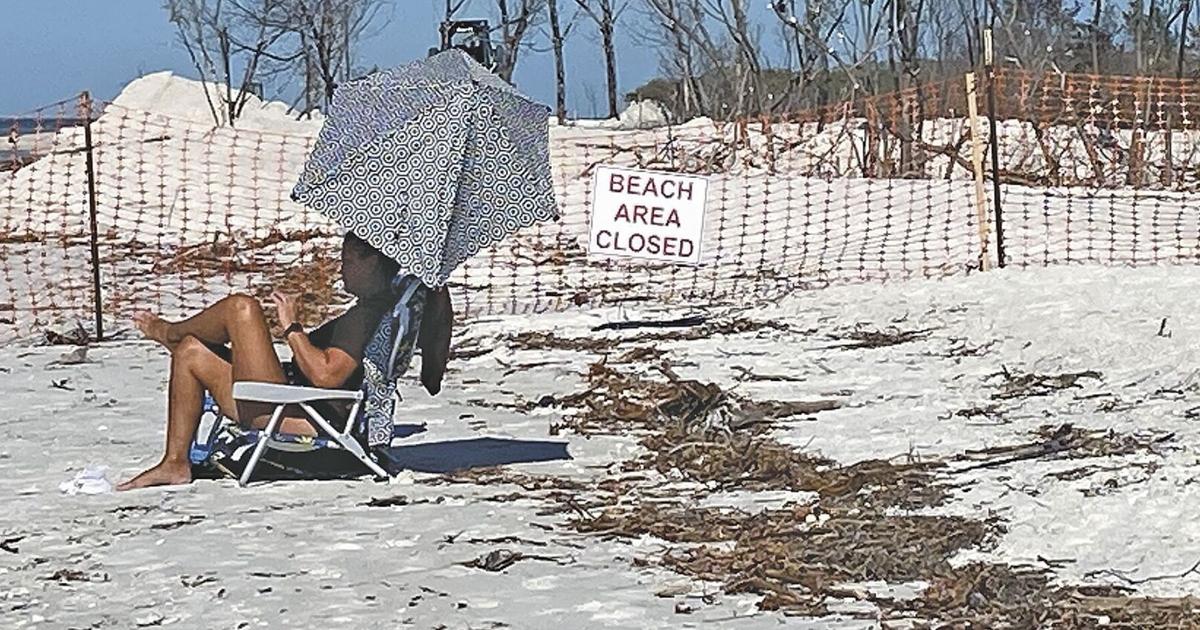“We are doing two things all at once – the scheduled maintenance and the recovery and restoration from Tropical Storm Debby and Hurricanes Helene and Milton,” reported Mohammed Dabees, Senior Engineer for Humiston & Moore. On December 12, 2024, the Hideaway Beach Taxing District met and received an update on the ongoing berm maintenance and repair on Sand Dollar Island.
According to Dabees, “Historical records show that the shoreline has been retreating at an average of 40-50 feet per year. If we do nothing and let nature take its course, we will eventually be at the waterline in a decade or two. The ecosystem restoration gives us the justification of why we are placing that sandy berm to protect the lagoon and the mangroves which are our natural base system for protecting the uplands as well as sustaining the system that is beneficial to other species that used to call this habitat home.”
What happened when the berm was constructed? According to Dabees “In the heels of Hurricane Ian, which happened after we’ve designed the project and put it to bid, we’ve made adjustments to accommodate the damages from Ian, but after the project was constructed, in a matter of two years, we were impacted by four hurricanes. Tropical Storm Debby created a breach at the northern part of the berm and that breach was further exacerbated by the impacts of Hurricane Helene and Milton. The south portion of the berm was washed over and welded onto the mangroves.”
Dabees added, “The good thing about our project is that we have permit authorization that allows us to go back after each storm and retrieve the sand and put it back where it was impacted by the storm. We are not going to reclaim every grain of sand, but we will reclaim enough to maintain the integrity of the sandy berm and be better prepared for the next storm. This is the concept of the whole project.”
What about the mangroves? At the December 12th meeting, Dabees reported “Right now, some of the mangroves’ roots are covered with sand; we are trying to assess the number of mangroves that need to be assisted to revive; assess areas that might need creating the right environment to plant mangrove seedlings; or to re-establish the shoreline; or if there is a need to add living shorelines.”
According to UF/IFAS, “Living shorelines are structures made of natural materials such as oyster shells, sand, mangroves, salt marsh plants, and other organic substrate built to protect properties from erosion.”
Approval for professional environmental and engineering services for continuing permit compliance monitoring for the Tigertail Lagoon/Sand Dollar Island by Turrell Hall & Associates for the first quarter of 2025 such as:
* Water Quality sampling/monitoring;
* Berm inspection reports;
* Vegetation; mangroves and submerge aquatic vegetation (SAV);
* Pre-sea turtle season escarpment survey;
* Sea turtle nest monitoring report per FDEP Permit;
* Twice monthly bird monitoring (plovers, red knots, shorebirds; skimmers);
* Annual bird nest habitat vegetation control (if needed, herbicide treatment following construction);
* Hand rolling sand spurs on spit.
A Purchase Order was approved for Earth Tech for an additional seven days at $49,000 for labor and equipment for excavation of overwash and sand placement.
Linda Ryan, Chair, stated that she would like to see future discussions not just on structures but also the use of dunes. Dabees added that discussions on structures are guided by statutes and rules that control means and methods of coastal protection. There are federal mandates for the protection of species like sea turtles, and putting barriers in the way is basically a violation of federal law.
Dabees provided an update on their application for State and Federal funding, adding that “We are meeting with FEMA’s preliminary assessment team and that we should be able to apply under Category G under COBRA (Coastal Barrier Resources Act) which restricts federal funding and assistance for development on storm-prone and dynamic coastal barriers.” According to Dabees, “that law has an exception for maintaining natural systems.”
